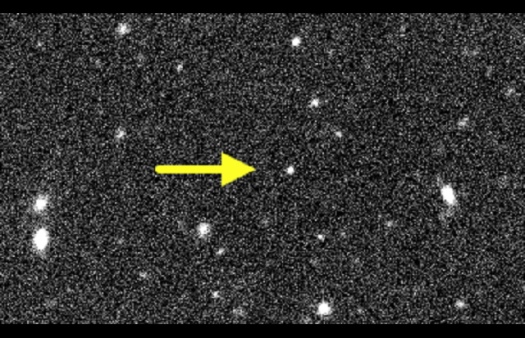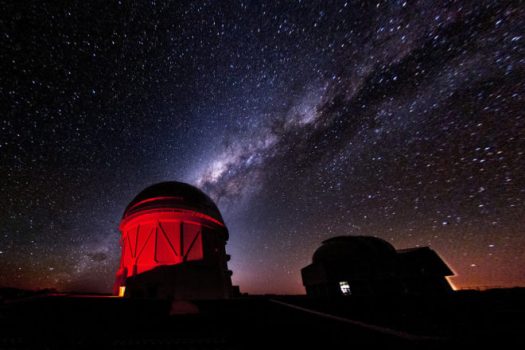
The race is on to find the giant planet that several teams of astronomers are convinced orbits far out beyond Pluto, but is nonetheless still part of our solar system. Proving the existence of what has become known as Planet X, or Planet 9, would be a discovery for the textbooks and would inevitably change our understanding of how our solar system was formed.
The technology and luck needed to image the planet (if it truly is there) has thus far fallen short, but the discovery of another set of distant solar system objects traveling in surprising orbits has added to the indirect findings that point to a substantial, and perhaps giant planet in the general vicinity.
The new findings come from Scott Sheppard of the Carnegie Institution for Science and Chadwick Trujillo of Northern Arizona University, who two years ago provided some of the first intriguing inklings that this distant planet might exist in our solar system. That information was subsequently modified and broadened by a California Institute of Technology team, but with the same conclusion that a substantial Planet 9 appeared to be present in the outer solar system.
“What we’ve just released is data on the first extreme objects since the {2014 and 2016} reports of a theorized Planet 9, and they show the same clustering and orbiting patterns that we think are likely caused by a major planet,” Sheppard said.
“This continues the trend of finding these objects — small dwarf planets or maybe icy objects — that were pushed into similar orbits in ways we think only planets can do.”
“We need more,” he said, “but the evidence is mounting, and at this point I’d say there’s an 80 percent likelihood that the planet is there.”

Some call the potential celestial object Planet X and some call it Planet 9 — as in, the ninth planet in our solar system now that Pluto has been demoted to a dwarf planet. But by any name, the interest is clearly high. The work underway by Sheppard and colleague Chadwick Trujillo of Northern Arizona University on distant solar system dynamics and orbits is supported by NASA, the National Science Foundation and the Department of Energy, as well as the Carnegie Institution.
Shepard spoke to me from Cerro Tololo Inter-American Observatory in the southern region of Chile’s Atacama Desert. He was about to begin an observing run for more small, distant, but definitely solar system objects, which can range from the size of Earth or Mars to a fraction of the size of Pluto. They become significant objects when they have the size and mass to become spheres, rather than jagged asteroids.

While the search is now primarily for these small objects, the goal is to find a scientific pathway to the potential Planet 9 — estimated to be between several and 15 Earth masses, and traveling in a very slow orbit that would circle the sun every 10,000 to 20,000 years.
Sheppard said that even if the planet was detected and its orbit determined, it would be so faint that current telescopes would probably wouldn’t be able to pull out important details and characteristics. But the next generation of much larger ground telescopes, as well as the James Webb Space Telescope, more possibly could.
As interesting to astronomers as the presence and characteristics of a possible Planet 9 might be, it’s also of great interest because of the story it might tell about our early solar system.
Sheppard explained: “If we find a very large planet, we’ll know it couldn’t have formed way out there – there just isn’t enough material available to form a big object. Most solar system objects should form in the region of Venus to Earth or Jupiter to Saturn.
“But if another big planet once inhabited those spaces, it would have created in an extremely chaotic environment. Inner planets would have all kinds of eccentric orbits because they would be pushed and pulled by the gravity of the big planet, or planets. So under this theory, at some point the Planet 9 had to get kicked out and over time migrate to its faraway orbit.
“The result is that the orbits in our solar system are now smooth, and the system has stability. I think it’s fair to say that if that a big Planet 9 had been kicked into the inner solar system rather than the outer solar system, then there’s very little chance that life could have begun and evolved on Earth — too much orbital chaos. In others, it was a crap shoot, and we may well have been very lucky.”
But there’s another possibility of how a Planet 9 might have arrived at its theorized general location, estimated to be at least 200 times further from the sun than Earth is. The alternative involves a Planet 9 exoplanet that had been been kicked out of another nearby solar system that formed in the general vicinity of ours. Such things are known to happen.
“If this turned out to be the case, then we’d know that there were other suns being formed nearby our sun,” Shepard said. “It would have to be a very dense solar environment, and that would also tell us a lot about the formation of our solar system.”

Object V774104 was discovered in late October, 2015, and is one of the most distant objects ever detected in the solar system. It appears to be about half the size of Pluto, but with an orbit two to three times wider than Pluto’s. (Scott Sheppard, Chad Trujillo and Dave Tholen: Subaru Telescope)
Sheppard’s team is conducting the deepest survey so far for objects beyond Neptune and the Kuiper Belt, a circumstellar disk that lies some 30 to 50 times as far as the Earth is from the sun. It is filled with dwarf planets asteroids, comets, and balls of frozen compounds — remnants of the earliest days of the evolution of the solar system. The Kuiper Belt is the region that includes Pluto, the now dwarf planet demoted several years ago.
The team has observed nearly 10 percent of the sky using some of the largest and most advanced telescopes and cameras in the world. As they find and confirm these distant and faint objects, they analyze whether their discoveries fit into the larger theories about how interactions with a massive distant planet could have shaped the outer Solar System.
“Right now we are dealing with very low-number statistics, so we don’t really understand what is happening in the outer Solar System,” Sheppard said. “Greater numbers of extreme trans-Neptunian objects must be found to fully determine the structure of our outer Solar System.”
He said that although astronomers believe there are thousands of these small objects, only about 15 have been positively identified. One discovered by Sheppard and Trujillo in 2014 — designated 2012 VP113 but nicknamed “Biden” — has the most distant known orbit in our solar system.
At the same time, Sheppard and Trujillo noticed that the handful of known extreme trans-Neptunian objects all clustered together and moved at similar orbital angles. These unusual dynamics lead the astronomers to propose that a substantial planet might be shepherding the smaller objects through its gravitational pull.

The search for Planet 9 is not the first to use the orbits of other bodies as a signpost to another planet. Indeed, Sheppard said that “we are now in a similar situation as in the mid-19th century when Alexis Bouvard noticed Uranus’ orbital motion was peculiar, which eventually led to the discovery of Neptune.”
The other team most deeply involved with the Planet 9 hunt is led by Mike Brown and Konstantin Batygin of the California Institute of Technology. They are the ones who made a big splash earlier this year with their predictions of a Planet 9, again based on the orbits of smaller objects.
In an email, we said that the newly detected object “fit perfectly into our Planet 9 hypothesis, so we remain pretty confident that the planet we predicted is indeed the right planet.”
Other groups searching the trans-Neptunian region for planets and information about the early solar system include the Canadian Outer Solar System Origins Survey and the international Dark Energy Survey.
Sheppard said that while the teams searching for Planet 9 are definitely in competition — a discovery would, after all, re-write the textbooks — they are also cooperating in terms of reporting back to each other if a region of the sky they study comes up with nothing to report. That way, he said, the teams won’t duplicate efforts where there is no promise of reward.
While Sheppard’s and Brown’s teams have the advantage of access to more sophisticated instruments to work with, it is certainly possible that one of the others will make breakthroughs, and possibly THE breakthrough.
“Actually, it’s quite possible that the planet has already been in some way imaged,” Sheppard said. “That happened with Uranus, Neptune and Pluto — they were observed but not understood before they were actually detected. Who knows, proof of Planet X {or Planet 9} may already exist in some observatory archive.”

I understand the lure of naming this object “planet 9”. However, it can be many things but not the “planet 9”. If current definition of a planet remains, this object can’t qualify as a planet (published, peer reviewed works about relation of the size of the object and its distance from the Sun needed to satisfy new part of the criteria for the planet imply that at this distance and size object can’t be a planet but only a “dwarf planet” [though in this case we maybe need another qualification like the Giant dwarf planet…]). If we retract new, modern definition of the planet and return to the older assumptions, this object could qualify to be planet 15 or planet 16 (or maybe more), but even pluto wouldn’t be a planet 9 anymore but planet 10.
Hence, case strengthens for a new type of solar system object, a giant dwarf planet…
LikeLike